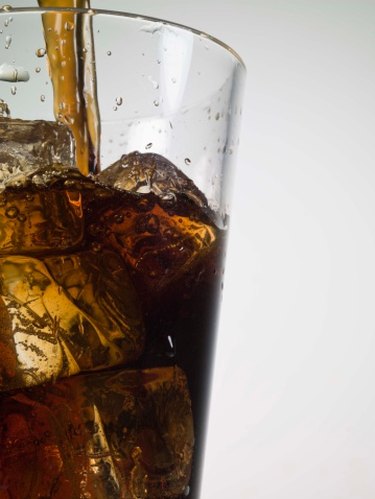
Many science teachers perform a demonstration in which they immerse sealed cans of Coke and Diet Coke in a tank of water. The can of Coke immediately sinks, while the can of Diet Coke floats. Some instructors have adapted this demonstration as an experiment to teach students the principles of density and buoyancy. The experiments allow students to conduct measurements so that they can devise a scientific explanation for the observed behavior.
Density
Video of the Day
Density represents the relationship between a substance's mass and the amount of space it occupies, i.e., its volume. Scientists normally express density in metric units of grams per milliliter, or g/mL. Pure water exhibits a density of 1.00 g/mL. Most other liquids exhibit densities between 0.8 and 1.3 g/mL.
Video of the Day
Composition of Coke
Coca Cola consists mostly of water. But it also contains 39 g of sugars, primarily in the form of high-fructose corn syrup, or HFCS. The HFCS used by Coca-Cola and most other soft drink manufacturers exhibits a relative sweetness of 160 compared to the baseline sweetness of 100 exhibited by sucrose, or table sugar. This relative scale reflects perceived sweetness, which means that HFCS literally tastes 1.6 times sweeter than an equal amount of sucrose. As a result, a drink sweetened with HFCS requires less sweetener to achieve the desired level of sweetness than a drink sweetened with sucrose.
Composition of Diet Coke
Diet Coke contains an artificial sweetener: aspartame. Aspartame exhibits a perceived sweetness of 180 times that of sugar. Or, for a more direct comparison, aspartame exhibits a sweetness 113 times greater than high fructose corn syrup. As a consequence, Diet Coke only requires 0.35 grams of aspartame to achieve the same level of sweetness as the 39 g of HFCS in Coke.
Buoyancy
Whether an object sinks or floats depends on its buoyancy. An object placed in water exerts a downward force on the water. The water, however, pushes back. Archimedes' principle states that the buoyant force exerted by water or any other fluid on an object is equal to the weight of the water displaced by the object. If the weight of displaced water exceeds the weight of the object, the object floats. Otherwise, it sinks. This, in part, explains why metal ships float. It also explains why the can of Diet Coke sinks. Because the two cans exhibit identical shapes and sizes, they displace equal amounts of water when submerged. But the fact that the can of Coke sinks means it must weigh more than the amount of water it displaces, whereas the can of Diet Coke weighs less.
Mathematical Explanation
Both the Diet Coke and Coke cans contain 12 fluid oz., or 355 milliliters, of liquid. Both beverages consist primarily of water. The primary difference lies in the sweetener. Coke contains about 325 mL of water, with a density of 1.0 g/mL, and 39 g of sugar. The contents of the can therefore weigh 325 g + 39 g = 364 g. The can of Diet Coke, however, contains only 0.3 g of aspartame. It therefore consists almost entirely of water and the can's contents therefore weigh about 355 g. This difference in weight makes the can of Diet Coke sufficiently buoyant to float. In terms of density, the density of Diet Coke is roughly 1.00 g/mL, the same as water. The Coke, however, exhibits a density of 1.03 g/mL.